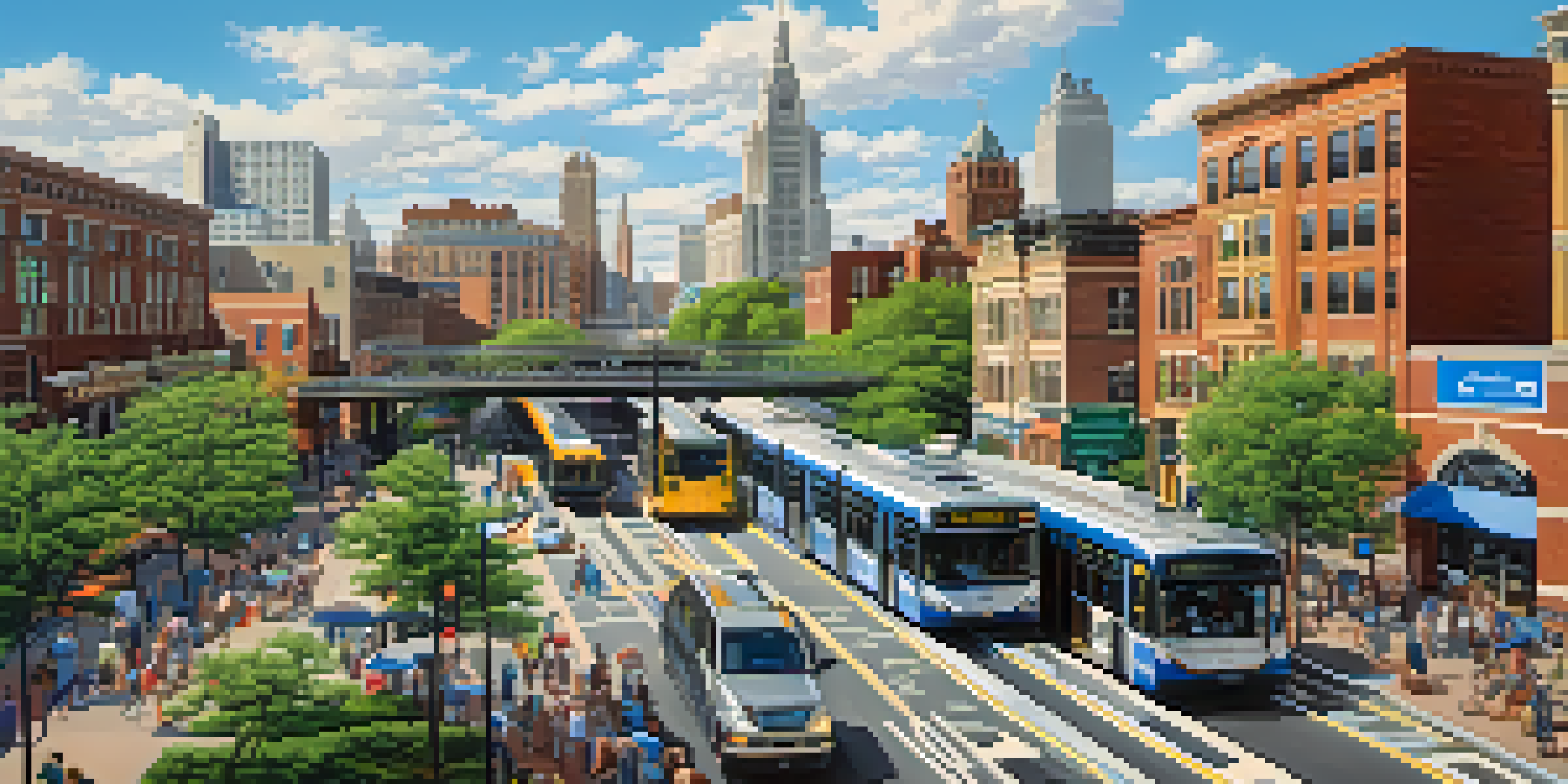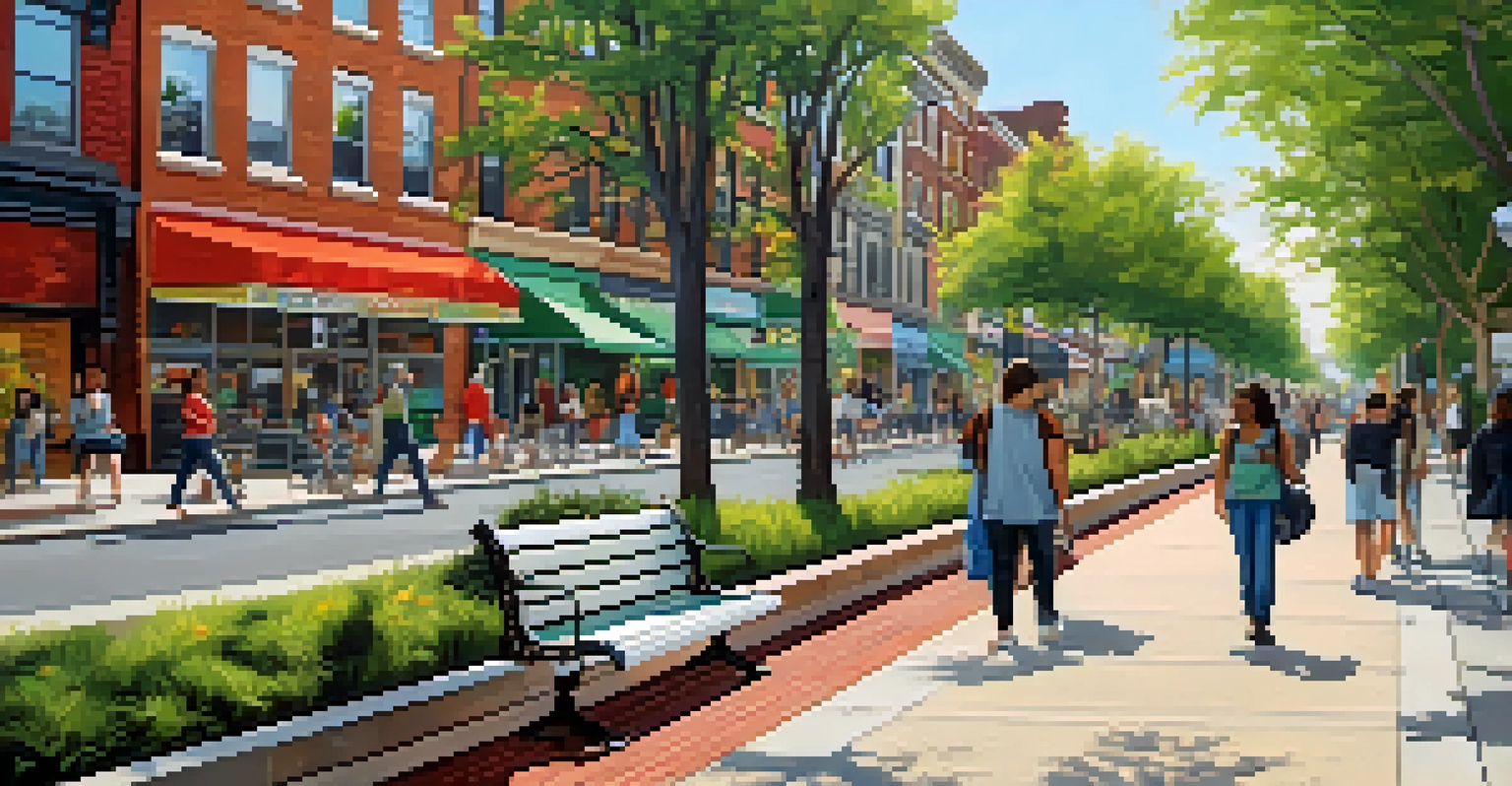Sustainable Transportation Initiatives in Newark: A Review

Introduction to Newark's Sustainable Transportation Efforts
Newark has been making strides toward sustainable transportation, focusing on reducing carbon emissions and improving public health. As a city with a rich history and diverse population, these initiatives aim to create a cleaner and more accessible environment for all residents. From public transportation upgrades to cycling infrastructure, Newark is setting an example for urban sustainability.
Sustainability is about a lifestyle that is in harmony with the environment, and that includes transporting ourselves in ways that minimize our impact on the planet.
The push for sustainability is not just about environmental concerns; it also aligns with economic growth and social equity. By investing in sustainable transport, Newark hopes to increase accessibility for underserved communities, ensuring everyone can benefit from these initiatives. This holistic approach emphasizes the importance of inclusivity in urban planning.
As we delve into the various initiatives undertaken by Newark, we’ll explore their impact on the community, the challenges faced, and the successes achieved. These efforts reflect a broader trend in many urban areas focused on creating a more sustainable future.
Public Transit Enhancements: A Step Forward
One of the key components of Newark's sustainable transportation strategy is enhancing public transit services. The city has invested in upgrading existing bus and light rail systems, making them more efficient and user-friendly. This includes increased frequency of services and better connectivity between different modes of transport.

These enhancements aim to encourage more residents to use public transport instead of personal vehicles, thereby reducing traffic congestion and lowering greenhouse gas emissions. Additionally, improvements in public transit can lead to a more equitable transportation system, as they provide affordable options for those who may not have access to a car.
Newark's Focus on Public Transit
The city is enhancing public transit services to reduce traffic congestion and promote accessibility for all residents.
Moreover, Newark's commitment to public transport is evident in its collaboration with regional transit authorities. By working together, they can create a seamless travel experience for users, which is essential for a vibrant urban community.
Expanding Cycling Infrastructure in Newark
Cycling is another critical aspect of Newark's sustainable transportation initiatives, with plans to expand bike lanes and shared bike programs. By promoting cycling as a viable mode of transport, the city aims to reduce reliance on cars and decrease carbon emissions. This initiative not only benefits the environment but also encourages a healthier lifestyle among residents.
The future of transportation is not just about reducing emissions; it's about creating communities that are accessible and enjoyable for everyone.
Newark has also introduced bike-sharing programs, making bicycles accessible to a broader audience. These programs allow residents and visitors to rent bikes easily, promoting a culture of cycling in the city. With more dedicated bike lanes, cyclists can navigate the city safely, boosting their confidence to ride.
Furthermore, community engagement is a vital element of this initiative. By involving residents in planning discussions, Newark ensures that the cycling infrastructure meets the needs of its users, making it a truly community-driven effort.
Electric Vehicle (EV) Initiatives in Newark
As part of its sustainable transportation strategy, Newark is actively promoting electric vehicles (EVs). The city has set up numerous charging stations to encourage residents to switch from gasoline-powered cars to EVs. This shift not only reduces air pollution but also supports the growing demand for clean energy solutions.
In addition to infrastructure, Newark is also exploring incentives for EV purchases, making them more financially accessible for residents. This could include tax breaks or rebates aimed at promoting the adoption of electric vehicles. Such initiatives signal the city's commitment to fostering a cleaner transportation ecosystem.
Emphasis on Cycling and Walkability
Newark is expanding cycling infrastructure and improving pedestrian areas to encourage healthier, more sustainable transportation options.
Moreover, Newark is collaborating with local businesses and organizations to raise awareness about the benefits of electric vehicles. By educating the community, they can dispel myths and encourage more people to consider transitioning to EVs.
Walkability: Making Newark Pedestrian-Friendly
Creating a walkable city is essential for promoting sustainable transportation, and Newark is taking steps to improve pedestrian infrastructure. Enhancements include wider sidewalks, improved crosswalks, and pedestrian-only zones that encourage walking as a primary mode of transport. These changes are designed to make walking not only safer but also more enjoyable.
By prioritizing walkability, Newark aims to reduce vehicle dependency and foster a sense of community. When people feel safe and comfortable walking, they are more likely to engage with local businesses and participate in community events. This revitalization can lead to a more vibrant urban environment.
Additionally, Newark is incorporating green spaces into pedestrian areas, making them more attractive and inviting. Parks and plazas provide essential recreational spaces, enhancing the overall quality of life for residents and visitors alike.
Community Involvement in Sustainable Transportation
Community involvement is a cornerstone of Newark's sustainable transportation initiatives. The city regularly hosts workshops and forums to gather input from residents about their transportation needs and preferences. This engagement ensures that any developments reflect the desires and concerns of the community, fostering a sense of ownership among residents.
Involving the community also helps to raise awareness about the importance of sustainable transportation. By educating residents on the environmental and health benefits of various initiatives, Newark encourages more people to participate in sustainable practices. This grassroots approach is vital for the long-term success of these initiatives.
Community Engagement is Key
Active community involvement ensures that transportation initiatives reflect the needs and desires of Newark's diverse population.
Furthermore, local organizations and advocacy groups play a crucial role in promoting sustainable transportation. Their efforts help amplify community voices, ensuring that the needs of various demographics are represented in planning discussions.
Challenges and Opportunities Ahead for Newark
While Newark has made significant progress in its sustainable transportation initiatives, challenges remain. Funding can be a barrier, as many projects require substantial investment and ongoing maintenance. Additionally, changing public perceptions about alternative transportation methods can take time and effort.
However, these challenges also present opportunities for innovation and collaboration. By seeking partnerships with private organizations and leveraging state and federal grants, Newark can secure the resources needed to advance its initiatives. Creative solutions, such as community funding or sponsorships, can also play a role in overcoming financial hurdles.

Ultimately, the success of Newark's sustainable transportation initiatives will depend on continued commitment from both the city and its residents. By working together, they can create a more sustainable, accessible, and vibrant urban environment for future generations.
Conclusion: A Sustainable Future for Newark
Newark's sustainable transportation initiatives are paving the way for a greener and more inclusive city. By focusing on public transit, cycling, electric vehicles, and walkability, the city is creating a comprehensive approach that addresses both environmental and social concerns. These efforts reflect a commitment to not just improve transportation but to enhance the overall quality of life for all residents.
As Newark continues to develop and adapt its strategies, the involvement of the community will remain crucial. Engaging residents in the process ensures that initiatives are tailored to meet their needs and aspirations. This collaborative spirit can serve as a model for other cities looking to implement similar sustainable practices.
In conclusion, Newark is on a promising path toward a sustainable future, and with ongoing support and innovation, the city can become a leader in urban sustainability. The initiatives implemented today will lay the groundwork for a healthier, more connected community tomorrow.